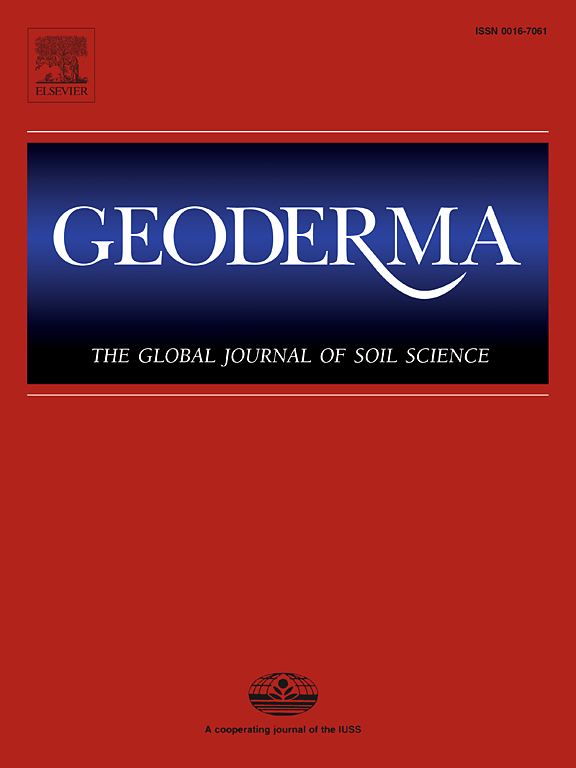Nitrogen fertilization-induced acidity and suitability of δ13C to study the dynamics of soil inorganic carbon in agroecosystems
IF 5.6
1区 农林科学
Q1 SOIL SCIENCE
引用次数: 0
Abstract
Neutralization of soil inorganic carbon (SIC), i.e., dissolution of carbonate minerals caused by N fertilization-induced acidity, is an ongoing reaction in agroecosystems that leads to significant contribution of SIC to soil CO2 emission. Analyzing δ13C natural abundance of the emitted CO2 is commonly used to quantify the contribution of SIC in total CO2 emission. However, carbonates recrystallization in isotopic equilibrium with soil respiration can lead to miscalculation, where despite detecting δ13C signal from carbonates in the emitted CO2, the SIC stock may not necessarily change. We tested the effects of ammonium sulfate, urea, chicken manure, liquid pig manure and no fertilization (i.e. control) on soil carbonates neutralization and the contribution of SIC in total CO2 emission over a 21 day incubation experiment. The alkali trap method was used to measure the total CO2 emission and the isotopic composition of carbon (C) in the emitted CO2 from the soil. Liquid pig manure followed by ammonium sulfate apparently led to the highest cumulative SIC-originated CO2 emissions, while chicken manure and urea showed equally the smallest amount. Nitrate can support the estimation of SIC-originated CO2 emission when nitrification is the only source of soil acidification. Dissolved Ca2+ concentration was a more robust proxy than for quantification of SIC-originated CO2 emission in our batch experiment, however, more evidences have to be collected before using Ca2+ as a proxy in open soil systems. Verification of the δ13C values by dissolved Ca2+ showed that the contribution of SIC to the total CO2 emission is overestimated after organic N fertilization, whereas an underestimation in the contribution of SIC to the soil CO2 emission was observed after inorganic N fertilization. In summary, the δ13C analysis could yield inaccurate results regarding the effects of N fertilization on the contribution of SIC in soil CO2 emission which should be considered in the future studies. From an environmental point of view, it can be concluded that when the amounts of N, especially in ammonium form e.g. amino groups are relatively high in organic fertilizers as it was the case in liquid pig manure compared to inorganic fertilizers, organic and inorganic N fertilizers lead to comparable amounts of SIC loss. This should be considered in applying organic fertilizers as a sustainable strategy to slow down the rate of soil acidification.

氮肥诱导酸度和δ13C适宜性研究农业生态系统土壤无机碳动态
土壤无机碳(SIC)的中和作用,即氮肥诱导的酸度导致碳酸盐矿物的溶解,是农业生态系统中一个持续的反应,导致SIC对土壤CO2排放的重要贡献。分析排放CO2的δ13C自然丰度是量化碳化硅在总CO2排放中的贡献的常用方法。然而,碳酸盐在同位素平衡中与土壤呼吸作用的重结晶可能导致计算错误,尽管在排放的CO2中检测到碳酸盐的δ13C信号,但碳酸盐储量可能不一定会发生变化。在21天的培养试验中,我们测试了硫酸铵、尿素、鸡粪、猪粪液和不施肥(即对照)对土壤碳酸盐中和和SIC在总CO2排放中的贡献的影响。采用碱阱法测定了土壤CO2总排放量和排放CO2中碳(C)的同位素组成。液态猪粪的累积碳源CO2排放量最高,其次是硫酸铵,鸡粪和尿素的累积碳源CO2排放量最低。当硝化作用是土壤酸化的唯一来源时,硝酸盐可以支持sic源CO2排放的估算。在我们的批量实验中,溶解Ca2+浓度比NO3-更可靠地代表了sic源CO2排放的量化,然而,在开放土壤系统中,Ca2+作为代理还需要收集更多的证据。溶解Ca2+对δ13C值的验证表明,施用有机氮后碳化硅对土壤CO2排放的贡献被高估,而施用无机氮后碳化硅对土壤CO2排放的贡献被低估。综上所述,δ13C分析对于氮肥对SIC在土壤CO2排放中贡献的影响的结果可能不准确,这需要在未来的研究中加以考虑。从环境的角度来看,可以得出结论,当有机肥中氮的含量,特别是铵态氮,如氨基的含量相对较高时,与无机肥料相比,液态猪粪中的情况就是如此,有机氮和无机氮肥料导致的SIC损失量相当。在施用有机肥时应考虑到这一点,将其作为减缓土壤酸化速度的可持续战略。
本文章由计算机程序翻译,如有差异,请以英文原文为准。
求助全文
约1分钟内获得全文
求助全文
来源期刊

Geoderma
农林科学-土壤科学
CiteScore
11.80
自引率
6.60%
发文量
597
审稿时长
58 days
期刊介绍:
Geoderma - the global journal of soil science - welcomes authors, readers and soil research from all parts of the world, encourages worldwide soil studies, and embraces all aspects of soil science and its associated pedagogy. The journal particularly welcomes interdisciplinary work focusing on dynamic soil processes and functions across space and time.
 求助内容:
求助内容: 应助结果提醒方式:
应助结果提醒方式:


